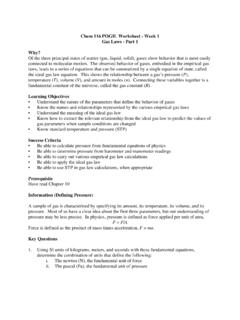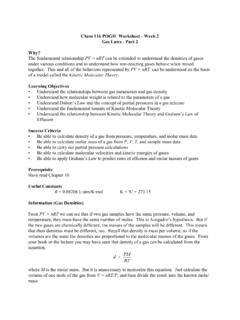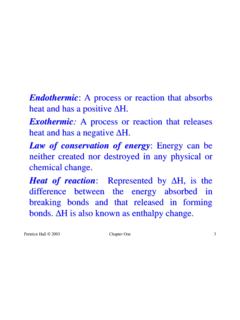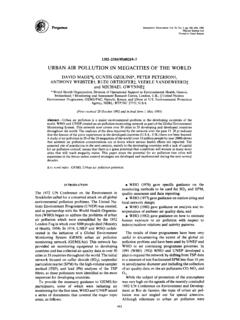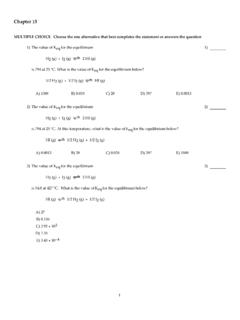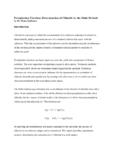Transcription of EXPERIMENT 3 FAJANS DETERMINATION OF CHLORIDE
1 EXPERIMENT 3. FAJANS DETERMINATION OF CHLORIDE . silver CHLORIDE is very insoluble in water. Addition of AgNO3 to a solution containing CHLORIDE ions results in formation of a finely divided white precipitate AgCl. This reaction provides a basis for DETERMINATION of CHLORIDE ions. The Analytical Reaction The reaction of AgNO3 with Cl- may be represented as: Ag+ + Cl- = AgCl (s). Suppose that we have a sample containing an unknown quantity of CHLORIDE ions. The number of moles (or weight) of CHLORIDE might be determined by titration with a silver nitrate solution of known concentration, C.
2 (This stuff doesn't grow on trees but its preparation is discussed shortly.) The known silver nitrate solution is added to the unknown CHLORIDE solution until we have added exactly the same number of moles of AgNO3 to the mixture as there are moles of CHLORIDE present. This is termed the equivalence point of the titration. NOTE: The term "titrate" refers to a process of addition of one substance to another. It implies that we seek to add just exactly the right amount. The equivalence point in a titration happens when, in fact, we have added just exactly the right amount.
3 The volume in mL of AgNO3 solution required to reach the equivalence point is symbolized by v*. Thus, v*C is the number of millimoles of AgNO3 required to react with all of the CHLORIDE present in the titration sample and because 1 mmole of AgNO3 reacts with 1 mmole of CHLORIDE , v*C is also equal to the number of millimoles of CHLORIDE present. The weight of CHLORIDE present is then mmole Cl- x mg/mmole =( v*C x ) mg. How will we establish the equivalence point volume of AgNO3 in the titration of CHLORIDE ? We will not. The equivalence point is a quantity that exists only in theory and in text books.
4 In the world we must satisfy ourselves with the "endpoint" which is an experimental estimate of the equivalence point. Our objective in a titration analysis is to match the experimental endpoint as closely as possible with the theoretical equivalence point. Just how this is to be accomplished depends on the amounts and nature of the substances involved in the analysis as well as the amounts and nature of other substances present in the sample. In any case we will assume that the experimental endpoint is an accurate approximation to v*. The FAJANS analysis for CHLORIDE employs a color-change indicator, dichlorofluorescein, to signal the endpoint of a titration of CHLORIDE ions with a "standard" AgNO3 solution.
5 We will assume that the visual endpoint of this titration is also the equivalence point and use this assumption to calculate the quantity of CHLORIDE present in an unknown sample. In other words, the analysis depends on two quantities: the concentration of "standard" AgNO3 solution and the endpoint volume v*, as follows. The AgNO3 Standard In the EXPERIMENT that follows we will use a AgNO3 solution of known concentration - a standard AgNO3 solution. This has been prepared in one of two ways. The first involves weighing out an appropriate amount of very pure solid AgNO3 then dissolving and diluting to an accurately known volume.
6 The resulting solution is said to employ AgNO3 as a "primary standard". A. second and preferable procedure involves analyzing a AgNO3 solution by titrating carefully weighed samples of pure NaCl whose CHLORIDE content is known. From the measured endpoint volume and known amount of CHLORIDE , C is calculated. In this case the AgNO3 solution is said to have been "standardized against a primary standard of NaCl" or, more simply, "standardized against NaCl". The first of these methods is certainly simpler but it is not widely applicable because it depends on the availability of the titration reagent in very pure form.
7 Additionally, this approach relies heavily on the assumption that the experimental endpoint volume really does accurately approximate the equivalence point volume. The second approach of standardizing against a standard sample is more commonly used and has the advantage of allowing for some "cancellation" of errors. This method is essential with complex analyses. We continue with a brief description of the dichlorofluorescein indicator to be used to signal the titration endpoint. The Indicator Reaction Consider the process of adding AgNO3 solution to a sample solution held in a flask and containing CHLORIDE ions.
8 At the start, when only a small amount of AgNO3 has been added, the solution contains some AgCl precipitate, a very small concentration of Ag+ ions and an excess of Cl- ions. (Cl- ions are just floating around "waiting" for the addition of more AgNO3.) When we have added just enough AgNO3 to reach the equivalence point the solution in the flask contains AgCl and very small and equal concentrations of Ag+ and Cl- ions. If we continue to add more AgNO3 to the flask very little additional AgCl is produced but the mixture now contains an excess of Ag+ ions.
9 That is, the Ag+ ion concentration is now greater than the Cl- concentration in the solution. Thus, the solution in the flask, the "analyte solution", is fundamentally different before and after the equivalence point. Before the equivalence point [Cl-]>[Ag+], but after the equivalence point [Ag+]>[Cl-]. We may take advantage of this change in the environment of the analyte solution. It is a general property of ionic precipitates like AgCl to adsorb their own ions from solution. Thus, a silver CHLORIDE precipitate standing in a solution containing excess CHLORIDE ions causes a layer of CHLORIDE ions to adhere to its surface.
10 Likewise, AgCl in the presence of a solution containing excess Ag+ ions forms an adsorbed layer of Ag+. If the solution contains dichlorofluorescein anion, some of this material will be adsorbed onto the layer of Ag+ ions present at the precipitate surface and form the red color of silver dichlorofluoresceinate. This silver salt would not ordinarily form in very dilute solutions of Ag+ and dichlorofluorescein anion. However, adsorption of Ag+ at the silver CHLORIDE precipitate surface results in a locally high concentration of Ag+ which is capable of precipitating red silver dichlorofluoresceinate onto the precipitate surface.




